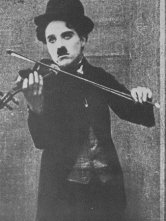The Vagabond

In my humble opinion, The Vagabond is the first of Chaplin’s films that can truly be called a masterpiece. I can and have enjoyed Chaplin’s work up to this point, but The Vagabond was the first time I was aware of getting swept up in a Chaplin movie.
The story is that Charlie is a vagabond violinist who plays for donations. His first scene, where he inadvertently takes the money that is due to a rival band, is as funny as anything Chaplin ever did, and it leads us to think this will be another of his broad comedies.
Then the main plotline is introduced: A mother (Charlotte Mineau) longs for her long-lost daughter (Edna Purviance), who has been kidnapped and enslaved by a band of evil gypsies. It’s as melodramatic as it sounds, which is no doubt what Chaplin intended. And yet, it’s presented all too plausibly. Edna’s (for lack of a better word) gypsy “boss” is played by Eric Campbell, but not with his usual over-the-top floridness; here, he is a genuinely heartless person who whips and bullies Edna. So when Charlie comes on the scene, we’re quite ready for him to get all fired up and rescue Edna from these nasties. And Chaplin delivers in spades, with a terrific rescue and rousing chase. (Rollie Totheroh’s camerawork here is superb; there’s a great shot taken from the back of the gypsy wagon occupied by Edna and Charlie, as Edna looks out and sees Eric and the other gypsies chasing them and just barely beyond reach.)
The second half of the movie begins with Charlie cleaning Edna up and fixing breakfast. Edna goes for a walk in the woods, where she comes upon an artist (Lloyd Bacon) who sees in Edna an inspiration for painting. He paints her portrait, and then Edna brings him around to Charlie for an introduction.
We know perfectly well where this is leading, but Chaplin eschews the usual chest-thumping this-girl-is-mine routine for something more heartfelt. Charlie knows Edna and the artist are falling for each other, and all the arse-kicking Charlie could give him wouldn’t change that.
The artist displays his painting in a gallery, and the mother recognizes the model as her long-lost daughter. A bittersweet reunion ensues, with Charlie doing his best to give Edna a friendly send-off as he’s left alone. Then comes the ending that people have debated for decades: A few miles down the road, Edna cries out for the car to be turned around – she realizes she really loves Charlie and goes back for him. Critics have said this ending is implausible, as the vagabond would have no place in Edna’s new world. I don’t agree, and I find it far more acceptable than the similar ending of The Kid. Maybe it’s because, Peter Pan-like, I wanted to believe.
In any case, the acting here is beyond reproach on all counts. Chaplin was famous for directing his actors to underplay, telling them, “Don’t sell it – remember, they’re peeking at you!” And the subtlety all throughout what could have been a histrionic story is just what “sells” it.
Another triumph from Chaplin’s Mutual period.
Click here to return to:
HomepageFilmography